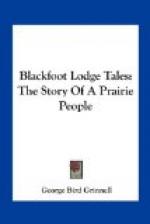[Footnote 1: See chapter on Religion.]
The I-kun-uh’-kah-tsi (All Comrades) were directly under the authority of the head chief, and when any one was to be punished, or anything else was to be done which came within their province as the tribal police, it was he who issued the orders. The following were the crimes which the Blackfeet considered sufficiently serious to merit punishment, and the penalties which attached to them.
Murder: A life for a life, or a heavy payment by the murderer or his relatives at the option of the murdered man’s relatives. This payment was often so heavy as absolutely to strip the murderer of all property.
Theft: Simply the restoration of the property.
Adultery: For the first offence the husband generally cut off the offending wife’s nose or ears; for the second offence she was killed by the All Comrades. Often the woman, if her husband complained of her, would be killed by her brothers or first cousins, and this was more usual than death at the hands of the All Comrades. However, the husband could have her put to death for the first offence, if he chose.
Treachery (that is, when a member of the tribe went over to the enemy or gave them any aid whatever): Death at sight.
Cowardice: A man who would not fight was obliged to wear woman’s dress, and was not allowed to marry.
If a man left camp to hunt buffalo by himself, thereby driving away the game, the All Comrades were sent after him, and not only brought him back by main force, but often whipped him, tore his lodge to shreds, broke his travois, and often took away his store of dried meat, pemmican, and other food.
The tradition of the origin of the I-kun-uh’-kah-tsi has elsewhere been given. This association of the All Comrades consisted of a dozen or more secret societies, graded according to age, the whole constituting an association which was in part benevolent and helpful, and in part military, but whose main function was to punish offences against society at large. All these societies were really law and order associations. The M[)u]t’-s[)i]ks, or Braves, was the chief society, but the others helped the Braves.
A number of the societies which made up the I-kun-uh’-kah-tsi have been abandoned in recent years, but several of them still exist. Among the Pi-kun’-i, the list—so far as I have it—is as follows, the societies being named in order from those of boyhood to old age:—
SOCIETIES OF THE ALL COMRADES
Ts[)i]-st[=i]ks’, Little Birds,
includes boys from
15
to 20 years old.
K[)u]k-k[=u][=i]cks’, Pigeons,
men who have been to war
several
times.
T[)u]is-k[)i]s-t[=i]ks, Mosquitoes,
men who are constantly
going
to war




